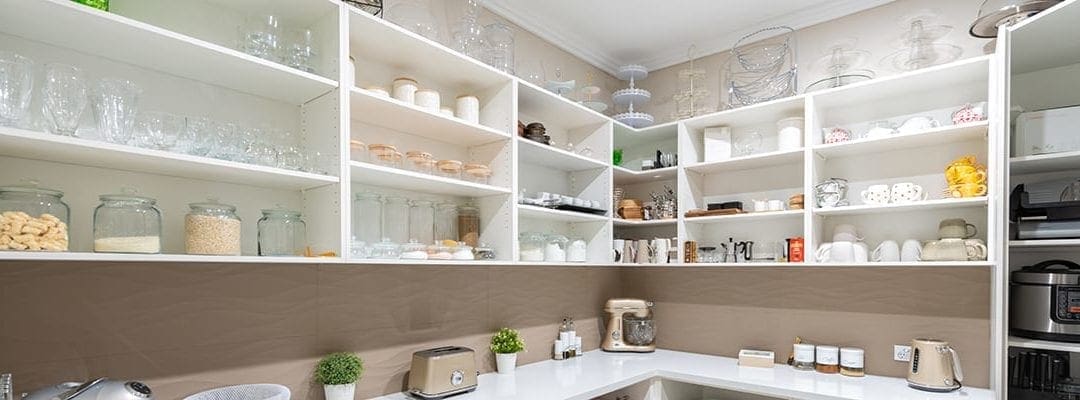As part of any new home build or renovation, there are always lots of options to consider and a seemingly endless amount of decisions to be made. It’s certainly no different when it comes to designing a Butler’s pantry.
Of course you want to make sure that the end result looks great, but as the Butler’s pantry is very much intended to be used as a workspace and will usually not be “on show” to your visitors and guests, it is perhaps even more important that first and foremost it is 100% practical and functional to your needs.
What makes a practical and functional Butler’s pantry?
There are a number of factors that can contribute to the overall success of a new Butler’s pantry. This can include things such as the amount of space available, the owner’s checklist of “must have” items and the level of professional expertise and knowledge available when it comes to designing and executing the project.
At the end of the day, designing a practical and functional Butler’s pantry space is really quite subjective. What is practical and functional for one household may be completely impractical for another? That is why it is so important, in the very early stages of planning, to narrow in on the individual specifics of exactly how the space is intended to be used in that particular house, for those particular homeowners. Once everyone has a clear picture, then appropriate recommendations and choices can be made in order to work towards meeting those needs.
Butler’s pantries are not necessarily complex but it’s important to get the simple details right
Not to take anything away from what has become a very popular and often integral part of an increasing number of homes, as there are some truly amazing and inspirational Butler’s pantries to ogle over, but at their very simplest, a Butler’s pantry is a combined storage and workspace area that can comprise a mixture of shelving, cupboards, drawers and bench space. Of course, on top of that core framework is scope for plenty of other bells, whistles and customisation, such as appliances, sinks and power points. In terms of ultimate practicality and functionality, the layout, cabinetry and storage space choices really are the critical features. Get those things right and you are well on your way to achieving a practical and functional Butler’s pantry. Get those core things wrong, and it can be a very expensive waste of time, money and precious space in your home.
What you do, determines what you need
Making the right choices for your Butler’s pantry cabinetry really comes down to what you are planning to do in there.
Will it be serving as a busy food preparation area for numerous large family functions and hosted events? Or perhaps more for improved (and expanded) food storage for the hungry inhabitants of your abode? Are you a gadget user and collector and need somewhere to better store and use your range of appliances? Or maybe you have a specific food or beverage related hobby or interest that you want to create a dedicated space for such as your very own coffee bar, cocktail area or juice or smoothie station?
Ultimately, the key functions of the space will dictate the main components and features that you will need in your Butler’s pantry. So how do you know what you need?
Will your Butler’s pantry have a partition or door?
In general, most Butler’s pantry spaces will have a door or are cleverly positioned behind a partition wall so that the contents of the space are not visible from the main living areas. In these cases, you might not need to consider installing cupboard doors or fully enclosed drawers in your Butler’s pantry as you would do in the main kitchen area, as simply shutting the door or closing off the partition is enough to hide away your trusty workspace and have everything looking neat and tidy. That is a personal preference though. Of course, if you are particularly passionate about having everything out of sight and tucked away, then, by all means, go for it. It may be wise to take some time to consider our points outlined here before you make your final decision though.
Butler’s Pantry Cabinetry Tip #1: Go for drawers down below
As has been seen with the popular use of drawers for storage in the main kitchen area, they can be equally, or perhaps even more, handy when used in a Butler’s pantry.
Drawers are a great option for storing a range of kitchen items from food products to tableware and appliances. The fact that you can extend the drawer out into space to easily view and access everything that is inside, makes them the preferred under bench storage option.
To make locating and accessing your stored items even easier, opt for open fronted drawers. Not only will it make it easier to access what you are after but it will make it much quicker to find and locate it too when you can see what is in the drawer without having to open it.
As with all design choices, there is an element of personal preference to be considered here too. If you prefer a more clean-line aesthetic in your space then completely closed drawer fronts are certainly an option. It’s important to find what works best for you, but remember that particularly in a Butler’s pantry, it’s as much about optimising practicality and function as it is about looks.
Butler’s Pantry Cabinetry Tip #2: Opt for open shelving up top
Unlike the main kitchen area, in a Butler’s pantry, there is often less necessity or requirement for cupboard doors. The focus is more about being able to quickly and easily find and access what you are looking for and less about having to keep things looking immaculately neat and tidy.
Open shelving is a perfect choice for your above bench and overhead storage needs in a Butler’s pantry. Shelving located above bench height is often narrower in depth than under bench shelving and so it is usually much easier to see and access items stored on those shelves. You might like to keep a small step ladder handy for those times when you need to grab something up a little higher.
If you are great at, or perhaps a little fanatical about, keeping things extremely well organised and orderly, then open shelving can also look visually pleasing. Even if you aren’t a fan of colour coordinating your storage containers or alphabetising your food items, open shelving can still be a great option. You could consider using baskets to keep common items together and readily accessible. Glass canisters or any other uniform-looking containers work well for storing bulk items such as cereals and grains as they look great and are practical too.
When planning your open shelving designs, be sure to incorporate an option for a variety of shelf heights to accommodate for various sized items that you will need to store in there.
Butler’s Pantry Cabinetry Tip #3: Do you really need those cupboard doors?
Some people are of the opinion that cupboards are mostly unnecessary in a Butler’s pantry space and can actually end up being more of a hindrance than a help. As we mentioned earlier, provided that your Butler’s pantry is able to be closed off with a door or adequately partitioned, then there generally is no need for cupboard doors.
As with everything, it really is a personal preference but make sure that you ask yourself if they are really necessary before going ahead with your choice. Will they help to make the space more practical or will it potentially make things more difficult having to open and close doors when you could be grabbing items off a shelf and quickly on your way? Consider that it is also easier, and more likely safer, to access shelves, particularly those that are overhead, when you don’t have to wrestle with a door.
If you decide that you would prefer to use cupboard doors in your Butler’s pantry area, we recommend that you reserve them for the overhead storage areas. They could serve well to tuck away rarely used items that you may not necessarily want to have on regular display and there is less chance of them impeding on the precious traffic flow areas in the space.
Use all the space
Whichever combination of cabinetry and storage solutions you choose for your Butler’s pantry be sure to use as much of the available space as you possibly can. We’ve said it before, and we’ll say it again, the Butler’s pantry is primarily a purpose-built workspace. So in order to get the absolute best practicality and functionality, you should make sure that you have everything right where you need it to get the job done.
At Harrington Kitchens, we are experts at helping you design your dream kitchen that looks amazing and suit your needs too, and that includes Butler’s pantries. Contact our team on 1300 662 112, submit an online enquiry or visit us at our Narellan or Bowral showrooms to discuss your dream kitchen with us today.


Recent Comments